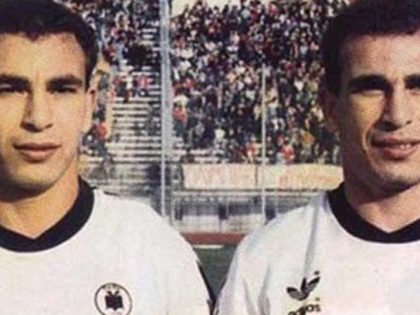Ghanaian film posters and viewing cultures
The posters are tied to the Ghanaian and Nollywood film industries that emerged in the late 1980s.

The exhibition, “Axe of Vengeance: Ghanaian Film Posters and Film Viewing Culture,” features hand-painted Ghanaian film posters made by Ghanaian artists in the late 1980s to mid-1990s advertising Hollywood, Kung Fu, Bollywood, Nollywood, and Ghanaian films.
This was commercial art for urban film houses and theaters that consisted of a television, a VCR, and a gas generator that traveled from town to town in a latter day mobile cinema. The posters were painted with oil and acrylic paints on large flour sacks and traveled too. Young boys often carried the posters around with a bell and announced the evening’s show (according to Indiana University African Studies Program director, Samuel Obeng, who spoke at the recent opening of the exhibition on the university’s campus in Bloomington, Indiana) offering an auditory component to the already compelling visual one. But as VCRs and TVs became more affordable to the average consumer, the theaters and poster painting associated with them disappeared.
I first saw this exhibit in Chicago where it was called Movie Mojo and the owner of the Chicago gallery that holds this collection, Glen Joffe, is preparing a book by the same title. There are other collections and a similar exhibit ran in Munich, Germany:
If you know these posters you may have seen Ernie Wolfe’s out of print book Extreme Canvas that also documents the phenomenon.
The posters are tied to the Ghanaian and Nollywood film industries that emerged in the late 1980s. Akin Adesokan, Carmela Garritano and Jonathan Haynes have done pioneering academic work on these industries, so check out their studies to learn what the intersection of the IMF, new technologies, economic crisis, novel aesthetics, and entrepreneurial innovation in tough times meant for West African film practice.
As Garritano points out, these videos, at least initially, pitted the new aesthetics of economically squeezed urban masses against the conservative, authenticist standards of a dispossessed, nationalist intelligentsia. Birgit Meyer points to the ways that Pentecostal religion’s emphasis on the visual facilitates its adoption of video film media. I think the posters have a static force that amplifies this effect.

While I once wondered — and there was some professorial grumbling about this at the exhibit opening — whether these posters feed negative stereotypes of the continent, I actually think just the opposite. As Glen Joffe put it in his gallery talk, these posters “win the war of engagement.” They are compelling as pieces of advertising cum art and as pieces of popular culture. They draw people in who might otherwise not ever have been interested or imagined that Africans watch B-flicks and Kung Fu movies like young Americans do. And hopefully they will get people to ask more questions about Ghanaian visual artists, Ghanaian film, and history and media. If comments on blog sites that show the posters are any evidence, some folks are now looking at Ghanaian and Nigerian films thanks to the poster paintings.
- This post falls under the category of Shameless Self-Promotion since Betsy Stirratt, Director of the Grunwald Gallery, Jeremy Sweet, associate Director of the Grunwald, and I brought this to Indiana University under the rubric of the 2012 Themester – Good Behavior, Bad Behavior. With many thanks to Nathan Donnelly for his photos of the exhibit opening.



















